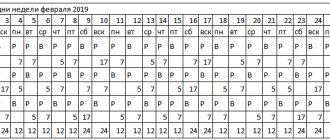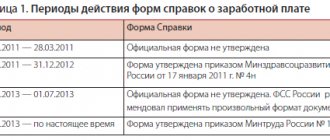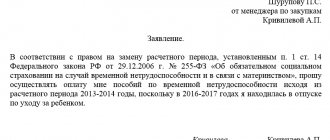17 working days and 14 days off | 5
19 working days and 9 days off | 5
20 working days and 11 days off
|
General provisions
According to the standards mentioned in Art.
91 of the Labor Code of the Russian Federation, every employer is required to keep time records for all units of working personnel. For these purposes, companies have created timesheets that are allocated for each employee. Such documentation is maintained by a special department based on each division of the organization. These calculations allow you to set salaries and maintain various types of company statistics.
There are also situations when one timesheet is not enough, especially if the company is engaged in multi-level production that requires separate estimates. In this case, it becomes important to correctly determine the units of accounting time that correspond to one hour of work of one employee or calculate man-hours using a universal formula.
Man-hours: what they are and why they were introduced
The concept of “man-hour” is one hour of work by one employee. To put it simply, these are labor costs that are incurred to carry out one operation by one employee.
For a better understanding, let’s give a simple example: packer Svetlana Arkadyevna packs 40 packs of dumplings in 1 hour. When it comes to a real-life situation, things get more complicated. And the value of man-hour for each specific case will be different.
This accounting unit is optimal for planning working hours and identifying the number of employees required for a specific job. For example, the above situation with a packer helps the management of a dumpling shop easily calculate the average number of employees required to pack 400 packs of dumplings in 1 hour of work. This is only 10 people.
Among other things, such an accounting unit allows you to determine the timing of various types of work if the enterprise has a certain number of personnel.
For example, if there are not 10 packers, but only 5, in this situation the administrator cannot sell 400 packs to wholesalers, which will be packed in 1 hour of work. The production operation time is extended by 2 hours.
If we draw a general conclusion from all that has been said, this unit of accounting for labor costs is necessary for multi-stage work that requires mandatory compliance with deadlines for each of the production operations.
If you know the time required to complete a certain amount of work by one employee, it becomes possible to calculate the exact number of hours and the number of specialists for each stage of the production process.
When certain tasks have strict deadlines, management can use similar formulas and calculations to optimize work.
According to the law, the following periods are not counted as man-hours worked:
- employee internships and vacations;
- sick leave;
- production downtime;
- maternity and nursing leave;
- shortened days for workers;
- strikes;
- other cases of employee absence from work, regardless of the safety of wages.
The simplest formula and complicated calculations
The simplest calculation formula of all proposed is as follows:
K * T = Hh, where
Hh is the number of man-hours, K is the number of employees who work on a specific task, T is the period of time to complete the task.
Companies are required to submit reports to the Federal Tax Service, Pension and other funds of the Russian Federation, as well as regularly notify Rosstat about the number of employees and their salaries. To send information in accordance with Rosstat Order No. 407 dated July 24, 2012, the company’s accounting department fills out form P-4 and other related forms.
This paper records the number of all shifts worked. Overtime (worked during holidays) and travel allowance is added to the amount of time taken into account. For example, a company officially employs 8 specialists on a full shift, and 4 of them worked on holidays (let it be May 3 and 4) for 4 hours. The calculation will be as follows:
4 * 144 + 4 * 152 = 1184
Holidays in Russia in 2021
The Labor Code of the Russian Federation in Article 112 establishes holidays that are considered non-working days throughout Russia:
- New Year holidays - from January 1 to January 8;
- Christmas - January 7;
- Defender of the Fatherland Day – February 23 and 24 (falls on Sunday);
- International Women's Day - March 8 and 9;
- Vesta and Labor Day - May 1, May 4-5;
- Victory Day – May 9, 11;
- Russia Day – June 12;
- National Unity Day – November 4th.
Subjects of the Russian Federation are allowed by Article 6 of the Labor Code to establish by their regulations additional holidays, including religious ones, when residents of a given territory are exempt from work.
For statistics
The generalized number of man-hours is used to identify various types of statistical data based on the relevant reporting documentation. A striking example of this is a situation where an organization needs to transmit information about the size of the company, the salaries of various categories of personnel and the hours worked over a certain period.
The indicator for statistical data when filling out form P-4 is taken into account using the following formula:
Chh = Ch1 + Ch2 + … + Chn, where
Chh is the number of man-hours worked, Chn is the time for which the next employee works.
The calculation of the indicator includes all overtime and travel allowances that are included in the schedule.
Organization with part-time employees
For companies that employ both full-time and part-time employees, additional calculations often become necessary. If, for example, a company employs 3 accountants, 4 managers, 5 mid-level workers for a 3.5-hour shift per day, the calculations will be as follows:
12 * 144 = 1728
For the remaining 4 specialists, the calculations are as follows:
4 * (4 * 18) = 288
If one accountant is dismissed on May 12, the given formula for him determines the following value:
1 * (8 * 5) = 40
Case studies
No. 1. Let's say there are 200 employees working in the production department of a factory. Let's consider the calculation of the indicator for June:
200 (workers) * 8 (time allocated per shift) * 24 (working days this month) = 19200 (man-hours)
No. 2. To calculate the required value, you should use the total number of hours worked per day allotted to each employee in the accounting sheet. If we consider a small organization that employs 12 people on a standard 8-hour shift, the daily time limit will be:
12 * 8 = 96 man-hours
The result must be multiplied by the number of days in the month:
96 * 21 = 2016
If we calculate this indicator for each employee and rely on a 5-day work week and an 8-hour day, the result shows:
21 * 8 = 168
No. 3. The company is decommissioning 3 people. In July, the standard working time was 20 days, with a 40-hour week - 167. One employee closed his time sheet this month, another 1 worked only 144 hours (on July 24-26 he took leave without pay) and 2 employees worked 64 hours (with part-time work, 4 hours a day) and 18-20 ended up on sick leave, i.e. missed 3 working days).
The company also employs 1 part-time worker. In June he worked 80 hours (20 working days of 4 hours each). So, the total number of man-hours for June in this organization is:
167 + 144 + 64 = 542 man-hours
If we talk about external part-time workers, then this figure is 80.
No. 4. Let a municipal institution employ 9 people. Seven of them worked a full month on a 9-hour day shift. There are 21 working days in a month. So, each employee worked:
21 * 9 = 189 hours
One person worked only 99 hours, because... I was on vacation for 10 days:
(21-10) * 9 = 99 hours
The third employee worked 180 hours and had 4 hours of overtime:
(21 * 9) + 4 = 193
If we calculate the total number for all employees, the result will be as follows:
189 * 9 + 99 + 193 = 1993 man-hours
Average number of employees: how to calculate the average number of employees in 2021
Every year, no later than January 20, LLCs and individual entrepreneurs must submit information on the average number of employees for the previous year.
Moreover, individual entrepreneurs submit this report only if they have employees on staff, and legal entities - regardless of the availability of personnel.
In addition, no later than the 20th day of the month following the date when the organization was created, information on the average number of employees of the newly created LLC must be submitted.
The reporting form KND 1110018 is simple, contains only one significant indicator, but the calculation of the average number of employees must be done taking into account the requirements of Rosstat, and this is not always easy. What is the average number of employees and how to calculate it?
Headcount
Before you understand what the average number of employees (ASN) is, you need to understand who is included in the payroll. According to the Directives of Rosstat (order dated November 22.
2018 No. 772), the payroll includes those hired under an employment contract, including the founders of the company if they receive a salary. The duration of the employment contract does not matter; even those who worked for only one day are taken into account.
Moreover, the calculation includes not only those who actually showed up for work, but also those who were absent from work for certain reasons.
The Rosstat Instructions provide a list of employees who are included in the payroll and those who are not.
Included in the payroll Not included in the payroll
|
|
To determine the number of payrolls, it is necessary to keep a time sheet every day, noting in it those who showed up for work and those who are absent for any reason. The forms of the report card are established by Resolution of the State Statistics Committee of Russia dated January 5, 2004 No. 1:
- T-12 – universal option;
- T-13 – for enterprises where automatic turnstiles are installed to record attendance.
When filling out a timesheet daily for each employee, hours worked and a symbol are indicated, for example:
- daytime - I;
- night time - N;
- overtime hours – C;
- business trip - K;
- annual basic paid leave - OT;
- maternity leave – P;
- temporary disability – B;
- failure to appear due to unknown circumstances – NN.
Next, based on the timesheet data, you need to calculate the average number of employees per month.
We count the payroll for the month
How to calculate the average number of employees for one month? Here is the calculation formula from the Rosstat Instructions: “The average number of employees per month is calculated by summing the payroll number for each calendar day, i.e.
from the 1st to the 30th or 31st (for February - to the 28th or 29th), including holidays (non-working days) and weekends, and dividing the resulting amount by the number of calendar days.
The number of employees on weekends and holidays is recognized as equal to that on the previous working day.”
Important: there are two categories of workers who, although counted in the payroll, are not included in the calculation of the average number of employees. These are women who are on maternity and child care leave, as well as those who have taken additional unpaid leave to study or enroll in educational institutions.
Here is the calculation of the average number of employees:
At the end of December, the average number of employees was 10 people. After the New Year's weekend, 15 more people were hired on January 11, and 5 people quit on January 30. Total:
- from January 1 to January 10 – 10 people.
- from January 11 to January 29 – 25 people.
- from January 30 to 31 – 20 people.
We count: (10 days * 10 people = 100) + (19 days * 25 people = 475) + (2 days * 20 people = 40) = 615/31 days = 19.8. Rounding up to whole units, we get 20 people.
To calculate the average number of employees for a month with several working days, you need to apply a different algorithm. For example, an LLC was registered on March 10, 2021, 25 people were hired under an employment contract, and the roster did not change until the end of March. How to be in this case?
The Instructions provide the following formula: “The average number of employees in organizations that worked for less than a full month is determined by dividing the sum of the number of payroll personnel for all days of work in the reporting month, including weekends and holidays (non-working) days for the period of work by the total number of calendar days in the reporting month. month."
We determine the amount of personnel from March 10 to March 31: 22 days * 25 people = 550. Despite the fact that only 22 days were worked, we divide the amount by the total number of calendar days in March, i.e. 31. We get 550/31 = 17.74, round up to 18 people.
Calculation of the net financial value for the reporting period
How to calculate the average headcount for a year or another reporting period? In reporting to the tax inspectorate, the SCR is compiled at the end of the year, and for filling out the 4-FSS form, the necessary periods are a quarter, six months, nine months and a year.
If the year has been worked out in full, then the calculation rule is as follows: (NW for January + NW for February + ... + NW for December) divided by 12, the resulting total rounded to whole units. Let's give a simple example:
The list of the enterprise for 2021 changed slightly:
- January – March: 35 people;
- April – May: 33 people;
- June – December: 40 people.
Let's calculate the average salary for the year: (3 * 35 = 105) + (2 * 33 = 66) + (7 * 40 = 280) = 451/12, total - 37.58, rounded to 38 people.
If the year has not been worked in full, then the calculation is made in the same way as for an incomplete month: regardless of the number of months worked, the amount of the NCR is divided by 12.
From the Rosstat Instructions: “If an organization has been operating for less than a full year, then the average number of employees for the year is determined by summing the average number of employees for all months of operation and dividing the resulting amount by 12.”
How to calculate the average headcount for less than a full year of work?
Let’s assume that an enterprise with a seasonal nature of activity worked only five months in a year, the monthly average was:
- April – 320;
- May – 690;
- June – 780;
- July – 820;
- August – 280.
We count: 320 + 690 + 780 + 820 + 280 = 2890/12. We find that the average is 241 people.
The calculation is carried out similarly for any other reporting period. If you need a report for a quarter, then you need to add up the cash balance for each month of real activity and divide the resulting amount by 3. To calculate for six months or nine months, the resulting amount is divided by 6 or 9, respectively.
Accounting for part-time work
In the examples given, we showed how to calculate the payroll for full-time employees. But what if they are employed part-time or part-time for a week? We turn again to the Directions: “Persons who worked part-time are counted in proportion to the time worked.”
To do this you need:
- Find out the number of man-hours worked by all part-time employees.
- Divide the result by the length of the working day, based on established standards, this will be the number of person-days for part-time workers for a given month.
Length of the working weekLength of the working day with a 5-day weekLength of the working day with a 6-day week
| 40 hours | 8 ocloc'k | 6.67 hours |
| 36 hours | 7.2 hours | 6 hours |
| 24 hours | 4.8 hours | 4 hours |
- Now the man-day indicator must be divided by the number of working days according to the calendar of the reporting month.
For example, at Alpha LLC, one employee works 4 hours a day, and the second - 3 hours. In June 2021 (21 working days), the two of them worked 147 hours at the rate of (4 hours × 21 days) + (3 hours × 21 days)). The number of person-days for a 40-hour week in June is 18.37 (147/8). It remains to divide 18.37 by 21 working days in June, we get 0.875, round to 1.
If you have employees who are employed full-time and part-time, then to get the total average number of employees for the year, you need to add up their average number of employees for each month separately, divide the result by 12 months and round.
Source: //www.regberry.ru/malyy-biznes/raschyot-srednespisochnoy-chislennosti-rabotnikov
The concept of labor costs in calculations
In addition to the accepted man-hours, there is the concept of “labor costs,” the formula of which is calculated using a similar calculation algorithm. The only difference is that a specific amount of time and labor units used are set for the work process (the calculation includes the cost of a certain job per hour).
Labor costs in general calculations are labor intensity, the formula of which is:
Tp = Тз / About, where
Tp – labor intensity, Тз – labor costs, About – volume of work performed.
There are different types of labor intensity indicator:
- full (total);
- technological (calculated based on work stages, number of parts, products, etc.);
- production (worker costs per product).
To this list is added the labor intensity of maintenance, which is allocated to auxiliary work processes associated with servicing production, as well as the labor intensity of management.
If we draw a conclusion about the difference between man-hours and labor costs, the difference lies only in the indicator of labor or time taken as a standard.
Concept of the term
A man-hour is the amount of labor time that is proportional to the hour a person works.
Additional Information
Often, this coefficient can be used to make a qualitative assessment of the work, which ultimately helps to determine how many people will be needed to complete the assigned task within the required time frame.
Man-hour is a cost indicator that is often necessary when drawing up long-term work in accordance with a heavy schedule. All labor costs must be recorded with timekeeping.
Attention
The indicator shows only working hours. It does not include vacation, lunch during the working day, as well as sick leave and other time free from work. This coefficient is an estimate that shows how quickly a task will be completed, and not a system by which people are counted. The function of calculating man-hours is analysis and planning.
Correctly assessing the efficiency and distribution of power in an enterprise is a very important and at the same time difficult task. Due to the calculated coefficients, the productivity and profitability of the company can be significantly increased. All senior members of the enterprise must use these criteria. The results obtained make it possible to optimize labor and increase the efficiency of employees. The criterion is calculated using simple formulas.
Where are they used?
Recording of man-hours and their costs is carried out in all organizations where there are hired employees. This value shows the hours allocated for work and the hours actually worked by all personnel. Various types of time are taken into account:
- calendar - the period of work of personnel, taking into account weekends and holidays;
- time-sheet - the time of the previous indicator minus days not intended for work;
- maximum - the number of hours possible for each employee to perform work during the reporting period;
- real - the time during which the employee actually performs his activities.
Another purpose of man-hours is used to calculate labor time, which is calculated using the formula:
K = Td / Tdr, where
K is the time allotted for work, Td is the actual hours worked, Tdr is the optimal number of hours.
Calculation nuances
When calculating the number of hours worked by employees, there are often small issues that need to be taken into account:
- If employees are on vacation, away for work, due to illness, or do not work the whole day, then this significantly complicates the calculation. In this case, it is necessary to use accounting for hours actually worked, and not the entire working day.
- Sometimes workers do not stay for the entire working day. In such cases, the coefficient is calculated individually for each person, and ultimately all the numbers are summed up.
- For real calculation, you need to keep a time sheet in which the working hours will be written. It contains information about each worker's working hours. When coming to work, the employee indicates the time of arrival, and when leaving, the time of departure. This is necessary to record the actual time worked.
- The total number of man-hours is compiled from the output of all workers of the enterprise.
- In order for the number to be calculated clearly, it is necessary to take away lunch time, the restoration of technical equipment, as well as the delivery of necessary items to the enterprise.
Comments Showing 0 of 0
Other similar quantities
This category of indicators includes a man-day - working time in a day, which on average lasts 6, 8, 9 and 12 hours. This indicator does not depend on the actual time worked and is most often used for planning projects with a possible long period of their implementation.
The day is used in the calculation of data such as:
- number of shifts worked;
- number of appearances and absences;
- downtime.
The categories of indicators with actual values include:
- days the employee is at the workplace and performs his direct duties;
- periods of business travel;
- cases of whole-day downtime, due to which employees performed related work.
A full-day period of downtime is understood as a whole working day when a specialist showed up to perform his duties, but was unable to start due to circumstances beyond his control.
The latter may be a lack of resources or equipment malfunction. Often in such cases, the management of the organization warns employees in advance about the problematic situation and allows them to miss a day of work.
If you calculate the total number of appearances, you should determine the sum of all days worked and downtime. Absences are calculated based on the following types of employee absence from the workplace:
- internship and vacation;
- absence due to illness;
- absences from work related to the performance of government duties;
- absence at your own expense (without pay);
- absenteeism (absence without good reason), etc.
Based on the man-day, auxiliary quantities are constructed:
- week - 5 or 6 person days, depending on the main value;
- month - 20-24 calendar days of working time;
- quarter - 3 working months;
- year and other values.
How to get people to work on a holiday
IMPORTANT!
Regarding the organization of work on non-working days due to the COVID-19 situation, please read our recommendations.
To involve an employee in performing work duties on a holiday, it is necessary to obtain his consent. It is possible to work on holidays if:
- suspension of work is impossible due to production and technical conditions (continuous production cycle);
- the organization serves the needs of the population (public transport);
- urgent repairs or commissioning are required;
- there was a need to carry out previously unforeseen work, on which the normal functioning of the organization depends in the future.
Without consent, the employee will be called to work on holidays only to prevent emergencies and accidents and to eliminate the consequences of such events. Whether holidays are paid with salary is established by labor legislation. An employer does not have the right to hire employees for free. This is a direct violation of workers' rights.
Cost for 2021
The indicator is calculated based on the number of employees who are busy performing a particular job and the number of hours that they actually worked for themselves.
If a specialist in 2021 fulfilled the full standard of allotted time according to the worksheet of a 40-hour work week, the number of man-hours will be equal to 1970.
If the number of personnel at the enterprise is equal to 20 units and full compliance with the allotted norm, the annual value of man-hours will be equal to 39,400.
It is important to remember that the number of man-hours per year should be calculated on the basis of timesheets and other documents recording working hours by calculating the sum of hours allocated to perform the duties of each specialist. This means that you can calculate the annual value of man-hours based on the following algorithm:
ChChg = ChG1 + ChG2 + …. + CHGn, where
ChChg is the total number of man-hours worked per year by all employees, ChGn is the total time for which the nth specialist actually worked.
This algorithm is a formula for calculating the actual number of man-hours worked per year. Such records can only be kept from the beginning of next year. The number of man-hours in the current period represents a planned value, which is only recommended to be adhered to.
The annual indicator until the end of the period can only be calculated based on the production calendar, which provides information about vacations, plans for hiring new personnel and other characteristics related to the movement of work units and control of working time.
As stated earlier, information on the number of man-hours worked in 2021 is only an approximate forecast.
Example: for 5 company employees who work a 40-hour week throughout the year with timely vacations (160 hours) and about 35 hours on sick leave, the calculated number of man-hours in the current year will be as follows:
(1970 – 160 — 35) * 5 = 8875
Postponement of holidays in 2021
Every year, the Government determines the days of rest that are subject to transfer due to falling on non-working holidays. This is necessary for the rational use of working time. The norm is fixed by the relevant Government resolution. In particular, in 2021, transfers are made according to Resolution No. 875 of July 10, 2019, and the non-working days will be: January 4 and 5 will be transferred to May 4 and 5.









